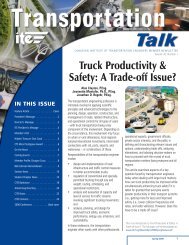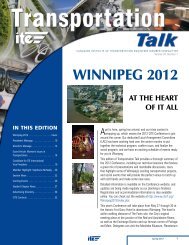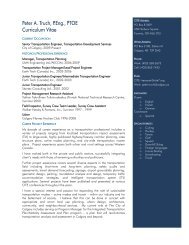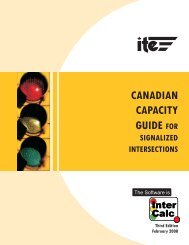Spring 2009 - Canadian Institute of Transportation Engineers
Spring 2009 - Canadian Institute of Transportation Engineers
Spring 2009 - Canadian Institute of Transportation Engineers
Create successful ePaper yourself
Turn your PDF publications into a flip-book with our unique Google optimized e-Paper software.
This is a truly dynamic and exciting time for ITE, despite the<br />
economic climate. There are challenges, to be sure, but ITE is<br />
focusing increasingly on issues and initiatives that are important to<br />
the membership and to the pr<strong>of</strong>ession at large.<br />
Before I get to the exciting stuff, just a quick economic note: the<br />
number <strong>of</strong> members who have not paid their dues has gone up quite<br />
a bit. I suspect that a lot <strong>of</strong> this may be more the result <strong>of</strong> people<br />
moving jobs recently, rather than the economic downturn. If you’re<br />
one <strong>of</strong> those who are in arrears, think about the value you get from<br />
ITE, and get online to renew, please! If you have an issue that’s<br />
stopping you, please tell the Executive about it... let’s work it out.<br />
It’s great to see that CITE’s growth continues to lead ITE as a whole.<br />
When I go the Board meetings, I’m always asked for the secret <strong>of</strong><br />
our success. I think it’s quite simply a testament to the energy and<br />
commitment <strong>of</strong> all the volunteers who participate actively in CITE,<br />
either at the Section or Chapter level, or through the Technical<br />
Liaison Committee, or in other venues. Let’s keep it up! And for<br />
those <strong>of</strong> you who aren’t volunteering, well, you don’t know what<br />
you’re missing. If you want to get <strong>of</strong>f the bench and into the game,<br />
we’ll be happy to involve you.<br />
Now for the interesting initiatives... every year ITE works on a<br />
number <strong>of</strong> “mega-issues” - sounds a bit like something from a<br />
graphic novel, doesn’t it - “The X-Men and their Mega-Issues.” But<br />
right now the mega-issue is the “Nexus between the Economy,<br />
Energy and the Environment.” A task force is working on developing<br />
products and forums that can be <strong>of</strong> service to ITE members and<br />
society at large with respect to this defining issue for our times.<br />
Right now, we are working on this as the theme for 2010 Technical<br />
Conference (to be held in beautiful Savannah, GA), and also on a<br />
scan <strong>of</strong> best practices and resources that can be made available to<br />
the members. Hopefully an issue <strong>of</strong> the ITE Journal will be dedicated<br />
to this theme later this year. If you’re interested in participating, if you<br />
have an idea for an article, or just have ideas to add, please let me<br />
know.<br />
The ITE Board has also been working for quite a while on the new<br />
ITE Strategic Plan. Developing documents like this is hard work,<br />
believe it or not. I was hoping it would be up the web by now, but<br />
apparently this is still in progress. Anyway... the Strategic Plan has a<br />
new mission statement for ITE: “To be the principal source <strong>of</strong><br />
pr<strong>of</strong>essional expertise, knowledge and ideas promoting<br />
transportation science and principles internationally.” It goes on to<br />
articulate the core purpose as “To advance transportation knowledge<br />
and practices for the benefit <strong>of</strong> society.” From those starting points, it<br />
defines core values, and goals for the three to five year horizon. ITE’s<br />
Board is now developing actions for <strong>2009</strong> and beyond. The Strategic<br />
Plan will continue to drive the Board’s direction for the coming years.<br />
I will endeavour to have it posted on the website.<br />
The Technical Conference in Phoenix was a success despite the<br />
economy, in terms <strong>of</strong> a good learning experience. Yes, attendance<br />
DIRECTOR’S<br />
was down, but there were still many good presentations and<br />
perhaps more importantly, informal exchange <strong>of</strong> helpful information.<br />
For example, the Signals Self Assessment Conversation Circle was a<br />
highlight <strong>of</strong> the gathering. You may remember that CITE participated<br />
in the Self Assessment; 28 municipalities completed the survey, and<br />
CITE produced the 2007 <strong>Canadian</strong> National Traffic Signal Report<br />
Card. Preparations are underway to conduct the next assessment,<br />
likely in 2010. In the meantime, though, your agency can continue to<br />
use the online tool for periodic self-assessments, through<br />
www.ite.org<br />
A representative <strong>of</strong> the City <strong>of</strong> Austin, Texas, Ali Mozdbar, provided<br />
his experience in use <strong>of</strong> the self-assessment to improve his city’s<br />
signals management performance. The City has 856 signals. They<br />
shifted their operational focus from a reactive mode (under which<br />
they focused on addressing resident complaints as quickly as<br />
possible) to a proactive mode, under which they now focus on<br />
preventative maintenance and adjusting signal timing plans. They<br />
have created more signal timing plans to address varying conditions.<br />
The City has found this significantly reduces citizen and political<br />
frustration. The representative also noted the importance <strong>of</strong><br />
documenting any program changes.<br />
Eddie Curtis, the second expert speaker in the conversation circle, is<br />
a representative <strong>of</strong> the Office <strong>of</strong> Pr<strong>of</strong>essional Development at the<br />
Federal Highway Administration. Mr Curtis does audits <strong>of</strong> municipal<br />
signal systems. He noted that frequently systems have no mission<br />
statement, which leads to poor performance because <strong>of</strong> lack <strong>of</strong><br />
specific goals and performance measures. A good starting point is to<br />
ask the question “what is traffic signal operations?” This leads to<br />
prioritization <strong>of</strong> activities, and definition <strong>of</strong> preventative maintenance<br />
objectives. He also noted the importance <strong>of</strong> training and/or adding<br />
staff when upgrading technology - many U.S. agencies do not have<br />
training or certification requirements for positions. Mr. Curtis’ agency<br />
is working on a template for the components <strong>of</strong> a traffic signals<br />
management program, to provide enhanced guidance.<br />
Lastly, I want to encourage all <strong>of</strong> you to attend the District<br />
Conference in Montréal. It’s a great city, and they are planning a<br />
unique and stimulating conference! Venez!<br />
...................................... Jim Gough, P.Eng., FITE<br />
District Director<br />
MESSAGE<br />
<strong>Spring</strong> <strong>2009</strong> 5









